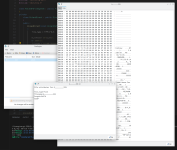hjalfi
Experienced Member
I have it working --- see screenshot. Some notes:

- I am not convinced the filename is right. There's clearly a machine-readable filename in the directory and a human-readable one in the file header, but I am unsure whether the 333 is part of the filename or represents something else.
- The maximum file length appears to be 48kB. This seems a bit small. It'd be nice to find a way to put big files on the disk and see what happens.
- The code can easily get confused by bad sectors leading to a corrupted directory.
- Decoding the contents of the files is a different problem to decoding the file system!

